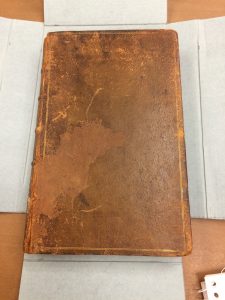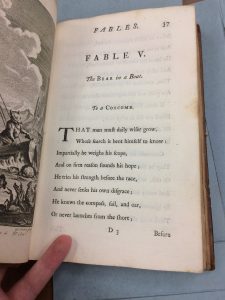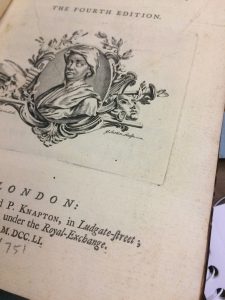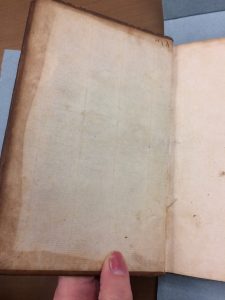On Wednesday, January 25th, Savannah Willard and I paid another visit to the archives of the University of Montevallo. During the bulk of today’s meeting, Mr. Carey Heatherly was in a meeting, so I got to go in and pull the books for Savannah and I to observe and interact with for this assignment.
 The book that I had the pleasure of looking at was Fables by John Gay, Volume 2, 4th edition. It was published in London in 1746, still in its original leather binding. On the spine, the whip stitching (the ridges on the spine, where the pages have been physically stitched together) was visible. It was bound together with five whip stitches. The book was in relatively good condition, only the corners of the covers having worn through the leather over time. None of the pages were falling out, and it felt stable as I opened it.
The book that I had the pleasure of looking at was Fables by John Gay, Volume 2, 4th edition. It was published in London in 1746, still in its original leather binding. On the spine, the whip stitching (the ridges on the spine, where the pages have been physically stitched together) was visible. It was bound together with five whip stitches. The book was in relatively good condition, only the corners of the covers having worn through the leather over time. None of the pages were falling out, and it felt stable as I opened it.
The paper was without a doubt laid paper. Chainlines (marks from the paper-making process, pictured left) running horizontally were visible throughout the entire book, and on the first one or two pages on either cover you could also see them running vertically. The pages were high quality, neatly trimmed and all of them opened. I could not find any evidence of a watermark, unfortunately.
There were several signatures on the bases of pages. They started at B, and would go in a pattern of letter, letter 2, letter 3, letter 4 (for example: B, B2, B3, B4) on the right hand page for four consecutive pages. They would then be followed by four pages without printing signatures. Only pages that had text would have signatures There were also images in the book, but they were printed on slightly thicker paper and never had signatures nor print on both sides. They also were not  inserted at regular intervals into the book, leading me to believe that they were added to the pages later, after the text content had been folded and arranged. The images coordinated to the fables, and probably had to be inserted afterwards in order to align with the correct fable. When one removed the image pages from the equation, the signatures started every eight pages, except for the last two sets, which were four and two pages respectively.
inserted at regular intervals into the book, leading me to believe that they were added to the pages later, after the text content had been folded and arranged. The images coordinated to the fables, and probably had to be inserted afterwards in order to align with the correct fable. When one removed the image pages from the equation, the signatures started every eight pages, except for the last two sets, which were four and two pages respectively.
 The typeset of this book had been punched in very firmly. Every single page was ridged with the letters that were on the other side, though I caught very few distortions of ink. There is a crest on the title page of the book that had been obviously pressed in after the other things, and left a very deep indention.
The typeset of this book had been punched in very firmly. Every single page was ridged with the letters that were on the other side, though I caught very few distortions of ink. There is a crest on the title page of the book that had been obviously pressed in after the other things, and left a very deep indention.
Based on the above evidence, but primarily on the frequency of the signatures, I would give the guess that this book was made in quatro style.
In learning about these things, I have definitely already noticed a change in my approach to books. Savannah and I were distracted when we went back into the archives to return the old books, looking at old student records accidentally because we thought the book was an old dictionary. I look forward to continuing to interact with the old books in our special collections, and learning more about their history.
